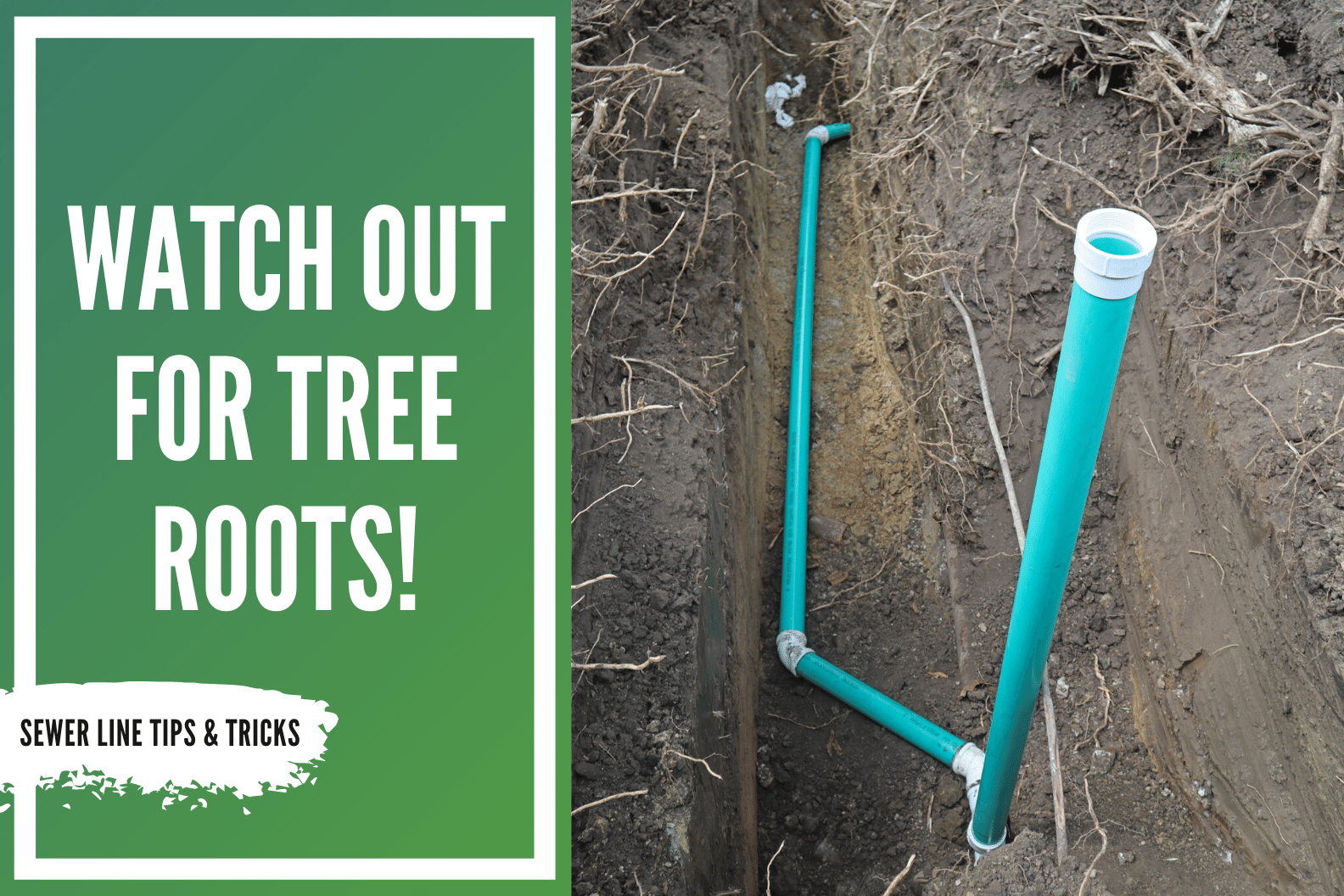Having been in the plumbing world for over 40 years, it’s safe to say that I’ve seen a wide range of plumbing issues. From your everyday clogged drains to basements flooding from a faulty sump pump, a lot of times these problems make themselves well-known. Having said this, that is certainly not the case 100% of the time. On plenty of occasions, you can’t even get eyes on the issue itself. That could be anything from a pipe bursting behind the wall or a sewer line cracking 10’ under the ground. For the purposes of this week’s blogpost, we’ll analyze sewer lines and how tree roots could be your worst nightmare!
Sewer line repairs can be a messy situation for all parties involved. As plumbers, advanced inspection cameras have certainly made our lives easier, but finding the exact area that needs repaired is easier said than done. For homeowners, it’s not hard to see why the issue can be troubling, just look at the picture below.
With this particular sewer line repair, these Kansas City homeowners had to have their concrete driveway tore out, a line stripped through the middle of the driveway and then the new sewer line laid. Add in backfilling and re-pouring the driveway, and you have quite the project! Obviously, not all sewer line repairs require concrete being poured, but you can probably start to see why they’re a costly repair.
Now we get to the main topic for this blogpost, which is tree roots wreaking havoc on sewer lines. Particularly in older homes, tree roots have continued to be a major disruption to a sewer line’s ability to do its job. One example of this is pictured below! The completed replacement is pictured in the thumbnail above, but just looking at the amount of excavation required tells you the full story.
How and why do tree roots invade sewer lines?
While variables such as temperature and soil depth have a large impact on tree roots growing, there’s no denying the fact that oxygen and water are critical to their growth. Particularly in the winter months where there’s not as much moisture, tree roots will attempt to travel wherever to find some water. Whenever there’s even the smallest of holes that may form within underground pipes, tree roots follow the moisture inside the pipe. Over time, they’re able to expand within the pipe and before you know it, you’ll have a major crack that requires an extensive replacement.
What should you be looking for?
Even though the above section seems rather self-explanatory from the surface, you still need to remember the underlying factor: all of these lines are more than a few feet underground. You may have a leak and not even notice anything is wrong until something major happens. While there’s no perfect way to keep eyes on your sewer lines, keep in mind that these lines affect more than a few areas of your complete plumbing system. As a result, their impact will be well-known fairly quickly! Here’s a few signs that something may be up underground:
1. Weird smell
As you might guess, whenever there’s a sewer line issue (or any other plumbing issue for that matter), there can be some funky smells that arise because of it. If your house smells a little weird for a random reason, it might be wise to get an experienced plumber out soon. It could be nothing, but it could also be a sewer line issue or even water damage from a busted pipe. In any case, exposed sewage can create health risks for all occupants of the house!
2. Grass is growing pretty quick
You obviously want to keep your landscaping looking good throughout the spring and summer seasons! However, if you notice everything is suspiciously growing too quickly or one area looks greener than the rest, there might be more to it! If everything is starting to look overgrown, that very well may be a result of the tree roots invading your sewer lines. Once this is done, all of that water has nowhere else to go and your grass is going to get more moisture than usual.
Additionally, be on the lookout for soggy spots in your yard. If there hasn’t been any rain for a few days, yet your lawn is still a little wet, there is likely a sewer line problem.
3. Rodents finding their way inside
I’m going to guess you don’t want rodents and insects finding their way into your home or business. Well, one easy avenue for them to be able to find their way through is a broken sewer line. Much like tree roots are able to squeeze through small cracks, rodents can also wiggle through. Once inside, they’re able to maneuver the piping and eventually into your home!
4. Slow drains
If most of your drains are running considerably slower and maybe even acting weird in other ways, you’re likely looking at some sort of plumbing issue. Granted it might not always be as serious as a sewer line and could even just be a routine clog, you can’t axe the sewer line as a potential culprit. At the same time, be on the lookout for odd situations that typically don’t occur. Something like flushing the toilet causing the shower drain to back up. This is an immediate giveaway that there’s likely an issue with your sewer line.
5. Severe issues
Depending on the size of the trees and the amount of time that the damage goes unnoticed, you could be looking at a much more severe issue than the images listed above. With this, I’m referencing sewer lines having the ability to cause sinkholes and even foundation issues! Despite these being more rare cases, they are possibilities, especially if your main line runs under a slab and isn’t detected for awhile. The result can be foundation cracking, home settlement and yes, possibly even a sinkhole!
What happens when the tree roots make their way through?
To start, it’s important to have an understanding of what type of material your sewer line is built out of. A few months ago, we covered most of these materials in our repiping blogpost. Just to recap, the key point to remember is that every material will eventually break down. Unfortunately, due to the amount of pressure they’re under on a routine basis, no material is unbreakable. Having said that, in terms of sewer lines, some materials are going to be more prone to root invasion than others. Clay tile pipe can be damaged by tree roots easily and likely won’t put up much of a fight. In comparison, sewer lines made out of PVC pipe have much fewer joints. Thanks to this, they are going to feature a much tighter fit and be less likely to leak out moisture around the pipes.
As briefly mentioned in the opening sections, when roots find their way into the pipe, they’ll continue to gradually grow and expand. As time goes by, this emits greater amounts of pressure on even the smallest of joints. As the pressure builds up, you’ll soon have a complete sewer line collapse.
Call your friends from Stine-Nichols
Here at Stine-Nichols Plumbing, we’re no strangers to sewer line issues. Having served the Kansas City area since 2014, we’ve become a trusted source for residential and commercial sewer line projects! If you ever feel something might be wrong with your sewer line or simply want to get it inspected to make sure, don’t hesitate to give our team a call at 816-348-3481. We know there isn’t a whole lot of time to waste on these types of issues and will do our best to have a plumber out to take a look in no time!



